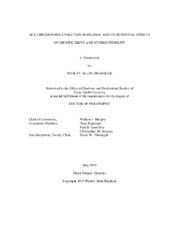| dc.description.abstract | The main motivation for this dissertation research was to gain a better understanding of mammalian sex chromosome evolution and its contribution to reproductive isolation between species. We first conducted a comparative study of the feline Y chromosome, beginning by sequencing approximately 10% (~2.4 MB) of the ampliconic region of the domestic cat Y chromosome. This allowed us to identify the major ampliconic gene families and repetitive units, and also provided a reference sequence resource for comparative analyses across the family. Using a combination of fluorescence in-situ hybridization, qPCR, and whole genome sequencing data from 20 different cat species, we found that Y ampliconic gene families are highly conserved across the family. These gene families remain conserved despite drastic changes in copy number and large structural rearrangements between species. The degree of conservation of the ampliconic region of the felid Y chromosome demonstrated the longevity with which these regions can be maintained, and provided additional evidence refuting predictions of the eventual demise of the mammalian Y chromosome. We then conducted a comparative analysis of four high-quality mammalian X chromosome assemblies, including human, pig, mouse, and the domestic cat, in order to assess patterns of amplicon evolution across Mammalia. Our results demonstrated that ampliconic regions were enriched for lineage-specific gene gains in all four species, but that a majority of these regions appear to have evolved in the common ancestor of eutherian mammals. We also determined that the mouse X chromosome is an outlier in the number of gene gains and losses, as well as the amount of X-linked ampliconic sequence. Evolutionary breakpoints in linkage between the derived mouse X and the ancestral eutherian X chromosome gene order appear to be enriched for ampliconic regions. We conclude that these regions act as hot spots for lineage-specific gene gains, as well as large-scale structural rearrangements. Our findings have refined and altered conventional ideas of sex chromosome evolution across Mammalia, and provide a novel understanding of how ampliconic regions evolve. We demonstrated that X and Y chromosome ampliconic regions have been maintained over long periods of evolutionary time, and may have conserved functional roles. | en |


